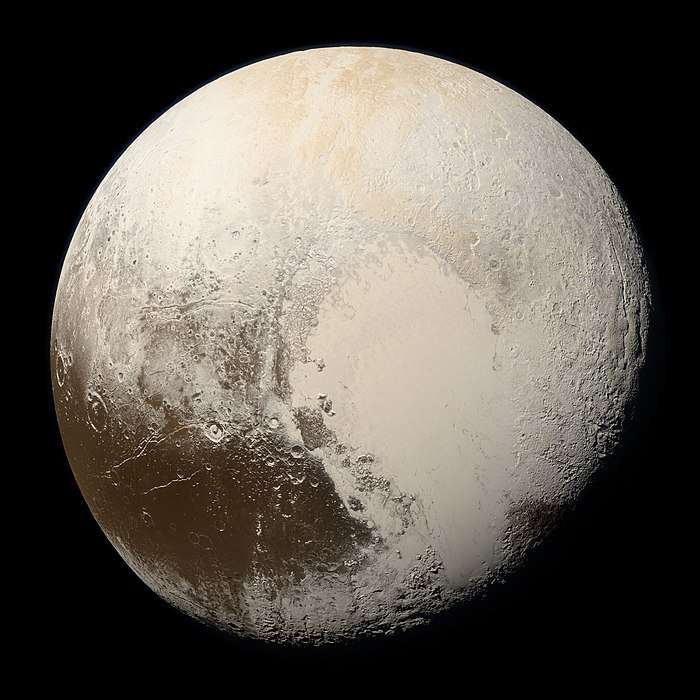Bright spots on Ceres
Several bright surface features (also known as faculae) were discovered on the dwarf planet Ceres by the Dawn spacecraft in 2015.

The brightest cluster of spots ("Spot 5") is located in an 80-kilometer (50 mi) crater called Occator.[1][2] The largest and brightest component of the cluster is in the center of the crater, with dimmer spots located towards this crater's eastern rim. Early in the orbital phase of the Dawn mission, the high albedo of these spots was speculated to be due to some kind of outgassing,[3] and subsequent closer images helped scientists determine that it is a material with a high level of reflection, and suggested ice and salt as possibilities.[4] These bright features have an albedo of about 40%, four times brighter than the average of Ceres's surface.[5]
On 9 December 2015, scientists reported that the bright spots on Ceres may be related to a type of salt, particularly a form of brine containing hydrated magnesium sulfate (MgSO4·6H2O); the spots were also found to be associated with ammonia-rich clays.[6] Arizona State University scientists have proposed that the bright spots are best explained as resulting from briny water erupted from Ceres's interior that subsequently sublimated, leaving behind only the salt deposits.[7] Near-infrared spectra of these bright areas are consistent with a large amount of sodium carbonate, (Na
2CO
3) and smaller amounts of ammonium chloride (NH
4Cl) or ammonium bicarbonate (NH
4HCO
3). These materials have been suggested to originate from the recent crystallization of brines that reached the surface from below.[8][9][10][11]
Researchers think that they have now found through crater counting that Occator crater is all that remains of the central mountain from an impact 34 million years ago. The bright material is only 4 million years old, and cryovolcanism may not have stopped completely as there is evidence of a thin haze, observed through variation in brightness, still present today, thought to be due to sublimating ice. Ice would not last long in such warm conditions exposed to the vacuum of space, so that would suggest it is being brought to the surface to this day.[12]
Spot 5
The brightest cluster of spots ("Spot 5") is located in an 80-kilometer (50 mi) crater called Occator,[1][2] which is located at 19.86° N latitude; 238.85 E longitude.[1][2]

The spot in the center of the crater is named Cerealia Facula,[13] and the group of spots to the east - Vinalia Faculae.[14] These names were approved by International Astronomical Union 26 November 2016.
Alan Duffy of Swinburne University suggested "a meteorite strike either shook covering material off the salty ice or heated it so that salty water rose to the surface as a geyser. The water escaped into space and now, only the salt remains."[15] A haze that fills around half of Occator crater and that does not extend over its rim[16] periodically appears around Spot 5, the best known bright spot, adding credence to the idea that some sort of outgassing or volcanism is occurring.[17][18]
Dawn's images led to widespread reports in the media about the bright spots, including in news sources,[19] astronomy magazines,[20] and science magazines.[21] An informal NASA poll during May offered the following ideas for the nature of the spots:[22] ice, volcanos, geysers, salt deposits, rock, or other.[23]
Asteroid specialist A. Rivkin noted, in an article by Sky & Telescope magazine, that at low angles a haze can be seen in but not outside of the crater, and speculated that this could be sublimated vapor from ice, possibly linked to the bright spots.[24]
Reflectivity studies from September 2015 suggest that the spots are probably salts rather than ice, implying that Ceres's interior is somehow delivering fresh salt to the surface.[25]
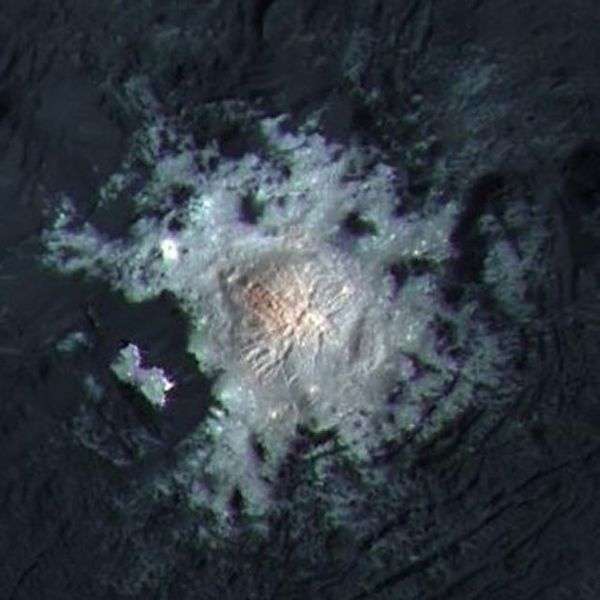
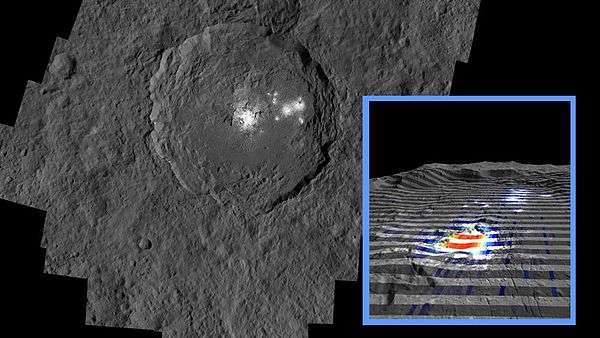
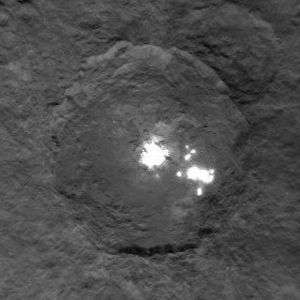
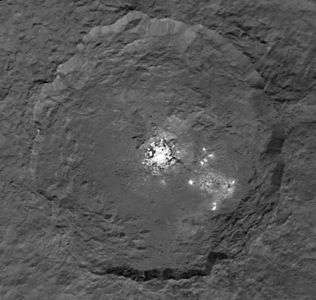
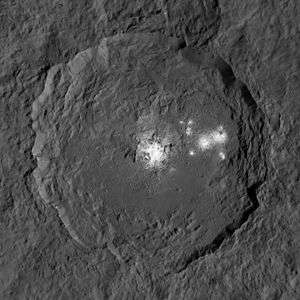
Spot 1
Planned observations
Dawn's closest orbit around Ceres is at a distance of 375 km (233 mi), started in early December 2015. This low-altitude mapping orbit (LAMO) was designed to acquire data for at least three months with Dawn's gamma-ray and neutron detector (GRaND) for gravity investigation and to determine the chemical composition on and near the surface.[4][26]
As late as September 2017, Dawn remained operational and orbiting at 28,700 km above Ceres.[27]
Gallery
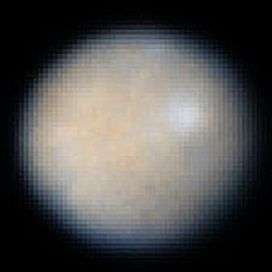
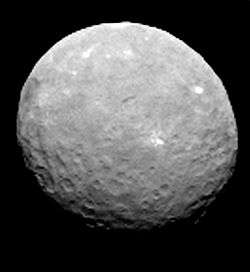
(12 February 2015)
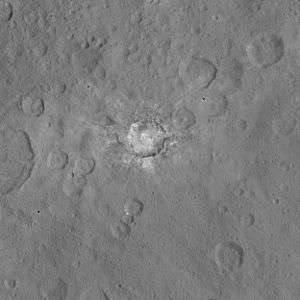

(6 June 2015)
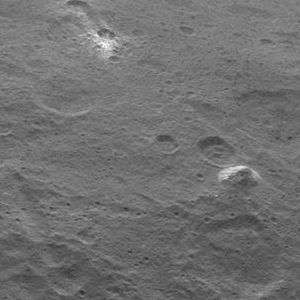
(6 June 2015)


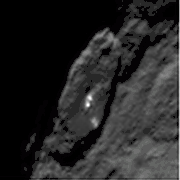
(4 May 2015)
| Ceres – dwarf planet |
|---|
 "Spot 1" (top row) (cooler than surroundings); "Spot 5" (bottom) (similar in temperature to surroundings) (April 2015). |

Final orbit-Bright Crater
(41 km (25 mi))
(July 2018)
Final orbit-BrightSpots ) (undo)
(288 km (179 mi))
(July 2018)

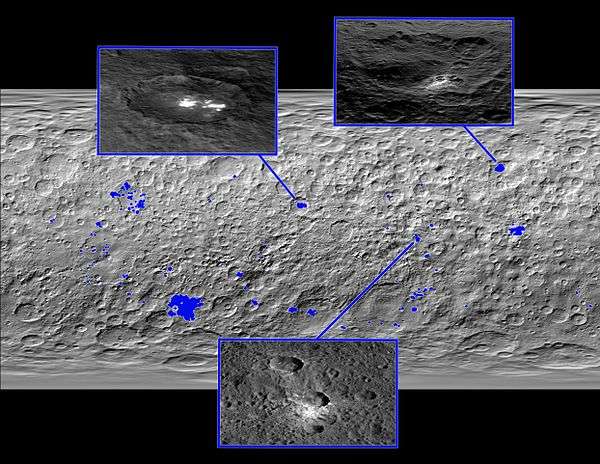
See also
- Ahuna Mons, the tallest mountain on Ceres
- Sublimation
References
- Staff (13 July 2015). "USGS: Ceres nomenclature" (PDF). USGS. Retrieved 16 July 2015.
- Staff (6 July 2015). "Planetary Names: Crater, craters: Occator on Ceres". USGS. Retrieved 16 July 2015.
- LPSC 2015: First results from Dawn at Ceres: provisional place names and possible plumes
- Feltman, Rachel (10 July 2015). "The weird white spots on Ceres might not be ice after all". The Washington Post. Retrieved 24 July 2015.
- Rayman, Marc (8 April 2015). Now Appearing At a Dwarf Planet Near You: NASA's Dawn Mission to the Asteroid Belt (Speech). Silicon Valley Astronomy Lectures. Foothill College, Los Altos, CA. Retrieved 7 July 2018.
- Landau, Elizabeth (9 December 2015). "New Clues to Ceres' Bright Spots and Origins". NASA. Retrieved 10 December 2015.
- https://asunow.asu.edu/20151215-deep-freeze-puts-squeeze-dwarf-planet-ceres
- Landau, Elizabeth; Greicius, Tony (29 June 2016). "Recent Hydrothermal Activity May Explain Ceres' Brightest Area". NASA. Retrieved 30 June 2016.
- Lewin, Sarah (29 June 2016). "Mistaken Identity: Ceres Mysterious Bright Spots Aren't Epsom Salt After All". Space.com. Retrieved 30 June 2016.
- De Sanctis, M. C.; et al. (29 June 2016). "Bright carbonate deposits as evidence of aqueous alteration on (1) Ceres". Nature. 536 (7614): 54–57. Bibcode:2016Natur.536...54D. doi:10.1038/nature18290. PMID 27362221.
- Preferential formation of sodium salts from frozen sodium-ammonium-chloride-carbonate brines – Implications for Ceres’ bright spots. Tuan H. Vu, Robert Hodyss, Paul V. Johnson, Mathieu Choukroun. Planetary and Space Science, Volume 141, July 2017, pp. 73–77
- Krummheuer, Birgit (6 March 2017). "Cryovolcanism on Dwarf Planet Ceres". Max Planck Institute for Solar System Research.
- "Cerealia Facula". Gazetteer of Planetary Nomenclature. USGS Astrogeology Research Program.
- "Vinalia Faculae". Gazetteer of Planetary Nomenclature. USGS Astrogeology Research Program.
- A. Duffy – Cosmos – What on Ceres are those bright spots?
- "Chris Russel at". Archived from the original on 24 July 2015. Retrieved 25 July 2015.
- Rivkin, Andrew (21 July 2015). "Dawn at Ceres: A haze in Occator crater?". The Planetary Society. Retrieved 24 July 2015.
- Dawn at Ceres: A haze in Occator crater? Posted by Andrew Rivkin
- Amos, Jonathan (2 March 2015). "Bright spotlight on Dawn mission to Ceres". BBC News. Retrieved 2 June 2015.
- Beatty, Kelly (3 March 2015). "Bright Spots on Ceres Intrigue Scientists". Sky & Telescope. Retrieved 2 June 2015.
- Witze, Alexandra (18 March 2015). "Bright Spots on Ceres Could Be Active Ice". Scientific American. Retrieved 2 June 2015.
- Staff (25 May 2015). "What's the spot on World Ceres?". NASA. Retrieved 25 May 2015.
- Cofield, Calla (22 May 2015). "What Are Those Bright Spots on Ceres? Go Vote!". Space.com. Retrieved 25 May 2015.
- Sky and Telescope magazine - Dawn Sees Ceres Bright Spots and More By Emily Poore July 30, 2015
- Ceres' Mysterious Bright Spots Aren't Made of Ice After All. Gizmodo, 1 October 2015
- "NASA's Dawn Fills out its Ceres Dance Card". NASA. 3 December 2013. Retrieved 24 July 2015.
- September 27, 2017 – Dawn Celebrates 10 Years of Spaceflight. Dawn Mission Status Updates. NASA.
- Landau, Elizabeth (28 July 2015). "New Names and Insights at Ceres". NASA. Retrieved 28 July 2015.
External links
| Wikimedia Commons has media related to Faculae on Ceres. |
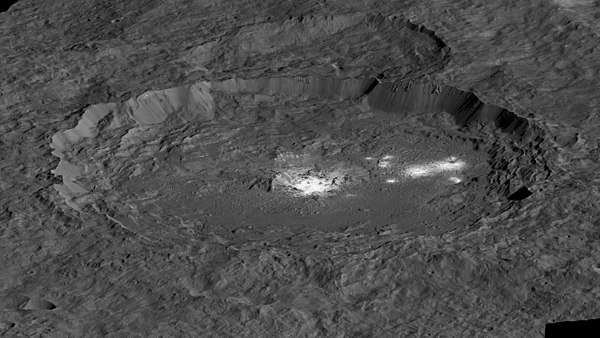
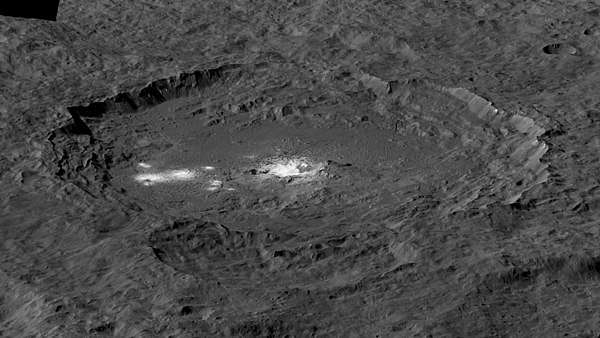
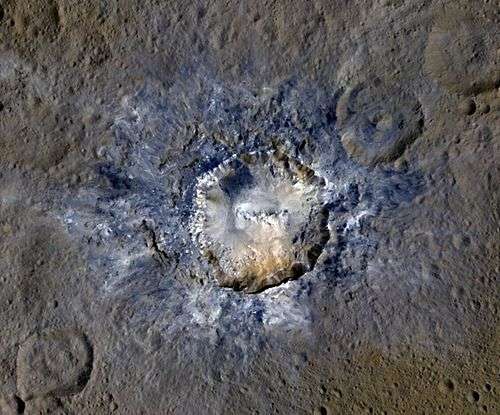
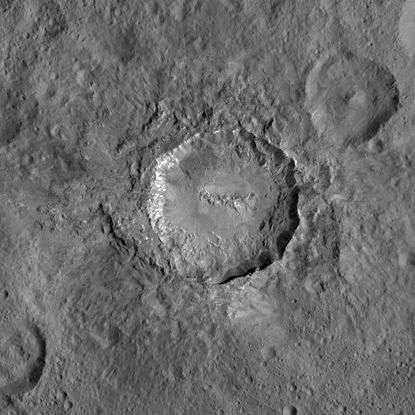
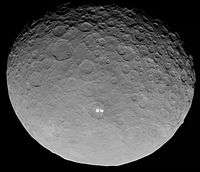
_(cropped).jpg)
